The incudopetrosal joint of the human middle ear: a transient morphology in fetuses
- PMID: 32159229
- PMCID: PMC7309281
- DOI: 10.1111/joa.13181
The incudopetrosal joint of the human middle ear: a transient morphology in fetuses
Abstract
In spite of the amount of research on fetal development of the human middle ear and ear ossicles, there has been no report showing a joint between the short limb of incus and the otic capsule or petrous part of the temporal bone. According to observations of serial histological sections from 65 embryos and fetuses at 7-17 weeks of development, the incudopetrosal joint exhibited a developmental sequence similar to the other joints of ossicles, with an appearance of an interzone followed by a trilaminar configuration at 7-12 weeks, a joint cavitation at 13-15 weeks and development of intraarticular and capsular ligaments at 16-17 weeks. These processes occurred at the same time or slightly later than any other joint. Thus, the joint development might coordinate with vibrating ossicles in utero. The growing short limb of incus appeared to accelerate an expansion of the epitympanic recess of the tympanic cavity. Additional observations of five late-stage fetuses demonstrated the incudopetrosal joint located in the fossa incudis joint changing to syndesmosis. Consequently, a real joint with a cavity existed transiently between the human neurocranium and the first pharyngeal arch derivative (i.e. incus) in contrast to the tympanostapedial joint or syndesmosis between the neurocranium and the second arch derivative. The newly described joint might have an effect on the widely accepted primary jaw concept: the mammalian jaw should thus have been created within the first pharyngeal arch, although the connection with neurocranium by the stapes is of a different origin.
Keywords: human fetus; incudopetrosal joint; incus; middle ear; otic capsule.
© 2020 Anatomical Society.
Figures


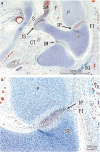
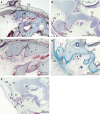
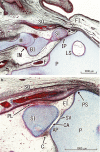
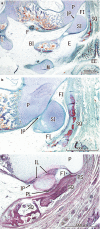
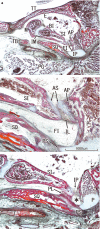



Similar articles
-
Development of the Human Incus With Special Reference to the Detachment From the Chondrocranium to be Transferred into the Middle Ear.Anat Rec (Hoboken). 2018 Aug;301(8):1405-1415. doi: 10.1002/ar.23832. Epub 2018 May 2. Anat Rec (Hoboken). 2018. PMID: 29669196
-
Fetal development of the elastic-fiber-mediated enthesis in the human middle ear.Ann Anat. 2013 Oct;195(5):441-8. doi: 10.1016/j.aanat.2013.03.010. Epub 2013 May 1. Ann Anat. 2013. PMID: 23706648
-
Bapx1 regulates patterning in the middle ear: altered regulatory role in the transition from the proximal jaw during vertebrate evolution.Development. 2004 Mar;131(6):1235-45. doi: 10.1242/dev.01017. Epub 2004 Feb 18. Development. 2004. PMID: 14973294
-
Development of the middle and external ear in man.Proc R Soc Med. 1977 Nov;70(11):807-15. doi: 10.1177/003591577707001134. Proc R Soc Med. 1977. PMID: 341170 Free PMC article. Review. No abstract available.
-
Major evolutionary transitions and innovations: the tympanic middle ear.Philos Trans R Soc Lond B Biol Sci. 2017 Feb 5;372(1713):20150483. doi: 10.1098/rstb.2015.0483. Philos Trans R Soc Lond B Biol Sci. 2017. PMID: 27994124 Free PMC article. Review.
Cited by
-
Fetal cervical zygapophysial joint with special reference to the associated synovial tissue: a histological study using near-term human fetuses.Anat Cell Biol. 2021 Mar 31;54(1):65-73. doi: 10.5115/acb.20.265. Anat Cell Biol. 2021. PMID: 33594011 Free PMC article.
-
Assessment of the ability of the radiological incudo-stapedial angle to predict the stapedotomy technique type: a prospective case-series study.Eur Arch Otorhinolaryngol. 2023 Nov;280(11):4879-4884. doi: 10.1007/s00405-023-08008-7. Epub 2023 May 17. Eur Arch Otorhinolaryngol. 2023. PMID: 37198302
References
-
- Aimi, K. (1971) The clinical significance of epitympanic mucosal folds. Archives of Otolaryngology, 94, 499–508. - PubMed
-
- Aimi, K. (1978) The tympanic isthmus: its anatomy and clinical significance. Laryngoscope, 88, 1067–1081. - PubMed
-
- Anson, B.J. and Donaldson, J.A. (1973) Surgical anatomy of the temporal bone and ear, 2nd edition Philadelphia: W.B. Saunders Company.
-
- Anson, B.J. , Hanson, J.R. and Richany, S.F. (1960) Early embryology of the auditory ossicles and associated structures in relation to certain anomalies observed clinically. Annals of Otology, Rhinology, and Laryngology, 69, 427–447. - PubMed
-
- Ars, B. (1989) Organogenesis of the middle ear structures. Journal of Laryngology and Otology, 103, 16–21. - PubMed
MeSH terms
LinkOut - more resources
Full Text Sources
Medical

